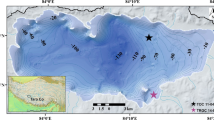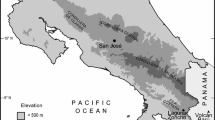Abstract
Lake sediment cores contain useful archives of severe past climate events (e.g. droughts, hurricanes, dust storms) and patterns of global climate change. Most such records come from higher latitudes in the Northern Hemisphere. Here we present sediment core data from shallow, equatorial Lake La Tembladera on the southern coast of Ecuador, which contains a > 100-year record of flooding events. We used geochemical properties of a 210Pb-dated sediment core to identify two distinct sedimentary facies. Facies one represents lake-derived deposits and is characterized by sediments with relatively higher organic matter and nitrogen content. Facies two represents flood events and is characterized by sediments with greater concentrations of inorganic carbon and terrigenous elements Al and Ti. Pollen from introduced Pinus sp. and Hg associated with recent gold mining provided independent time-markers in the sediment to validate the 210Pb chronology. The comparisons of the geochemical signal with the ENSO reconstructions revealed that the sediments contain a poor signal of ENSO from AD 1930–1965. The weak ENSO signal may result from minimal climate sensitivity in the lake or early water control efforts (e.g. rudimentary damming). However, from AD 1965, the climate signal is totally masked by recent and documented anthropogenic works such as dams and canals. This record shows how anthropogenic efforts to minimize societal impacts of ENSO floods have masked the natural climate signal and nicely mirrored recent trends between climate and anthropogenic activities in tropical latitudes.







Similar content being viewed by others
References
APHA-AWWA-WEF (1992) Standard methods for the examination of water and wastewater. American Public Health Association, Washington DC
Appleby PG, Oldfield F (1978) The calculation of lead-210 dates assuming a constant rate of supply of unsupported Pb-210 to the sediment. CATENA 5:1–8
Appleby PG, Oldfield F (1983) The assessment of 210Pb data from sites with varying sediment accumulation rates. Hydrobiologia 103:29–35
Appleby PG, Nolan PJ, Gifford DW, Godfrey MJ, Oldfield F, Anderson NJ, Battarbee RW (1986) 210Pb dating by low background gamma counting. Hydrobiologia 141:21–27
Banco de Desarrollo de América Latina (2000) Las lecciones de El Niño. CAF, Quito. http://scioteca.caf.com/handle/123456789/675
Binford MW (1990) Calculation and uncertainty of 210Pb dates for PIRLA project sediment cores. J Paleolimnol 3:253–267
Briones E, Gómez J, Hidalgo A, Tirira D, Flachier A (2001) Inventario de Humedales del Ecuador. Segunda Parte. Humedales Interiores de la provincia de El Oro, Ecociencia, Quito
Chung FH (1974) Quantitative interpretation of X-ray diffraction patterns. I. Matrix - flushing method of quantitative multicomponent analysis. J Appl Crystallogr 7:519–525
Conroy JL, Restrepo A, Overpeck JT, Steinitz-Kannan M, Cole JE, Bush MB, Colinvaux PA (2008) Unprecedented recent warming of surface temperatures in the eastern tropical Pacific Ocean. Nat Geosci 2:46–50
Dean WE (1974) Determination of carbonate and organic matter in calcareous sediments and sedimentary rocks by loss on ignition; comparison with other methods. J Sediment Petrol 44:242–248
Dixon MD, Boever CJ, Danzeisen VL, Merkord CL, Munes EC, Scott ML, Johnson WC, Cowman TC (2015) Effects of a ‘natural’ flood event on the riparian ecosystem of a regulated large-river system: the 2011 flood on the Missouri River, USA. Ecohydrology 8:812–824
Emile-Geay J, Tingley M (2016) Inferring climate variability from nonlinear proxies: application to palaeo-ENSO studies. Clim Past 12:31–50
Garreaud RD, Vuille M, Compagnucci R, Marengo J (2009) Present-day South American Climate. Paleogeogr Palaeoclimatol Palaeoecol 281:180–195
Geological Map of Ecuador (1982) E: 1:1000000. Ministerio de Recursos Naturales y Energéticos, Dirección General de Geología y Minas, Quito
Heiri O, Lotter AF, Lemcke G (2001) Loss on ignition as a method for estimating organic and carbonate content in sediments: reproducibility and comparability of results. J Paleolimnol 25:101–110
Instituto Nacional de Preinversion (2003) Estudio de Impacto Ambiental Definitivo Embalse de la Represa de Tahuín. Ecuador. INASSA, Quito
Kabat P, Claussen M, Dirmeyer PA, Gash JHC, DeGuenni LB, Meybeck M, Pielke RA, Vorosmarty CJ, Hutjes RWA, Lutkemeier S (2012) Vegetation, water, humans and the climate- a new perspective on an Interactive system. Springer, Dordrecht
Li J, Xie SP, Cook ER, Huang G, D’Arrigo R, Lui F, Ma J, Zheng XT (2011) Interdecadal modulation of El Niño amplitude during the past millennium. Nat Clim Chang 1:114–118
López-Blanco C, Sinev AY (2016) Cladocera biodiversity in La Tembladera Lake (Ecuador): a palaeolimnological approach. Crustaceana 89:1611–1637
López-Blanco C, Collahuazo L, Torres S, Chinchay L, Ayala D, Benitez P (2015) Mercury pollution in soils from the Yacuambi River (Ecuadorian Amazon) as a Result of Gold placer Mining. Bull Environ Contam Toxicol 95:311–316
Margalef R (1983) Limnologia. Omega, Barcelona
McCartney M (2009) Living with dams: managing the environmental impacts. Water Policy 11:121–139
McPhaden MJ, Busalacchi AJ, Cheney R, Donguy JR, Gage KS, Halpern D, Ji M, Julian P, Meyers G, Mitchum GT, Niiler PP, Picaut J, Reynolds RW, Smith N, Takeuchi K (1998) The Tropical Ocean-Global Atmosphere observing system: a decade of progress. J Geophys Res Atmos 103:14169–14240
Ministerio de Energía y Minas (1986) Investigación de la Minería en el Ecuador Tomo III Siglo XIX y XX. Ministerio de Energía y Minas, Quito
Moy CM, Seltzer GO, Rodbell DT, Anderson DM (2002) Variability of El Niño/Southern Oscillation activity at millennial timescales during the Holocene epoch. Nature 420:162–165
Oldfield F, Appleby PG (1984) Empirical testing of 210Pb-dating models for lake sediments. In: Haworth EY, Lund WG (eds) Lake Sediments and Environmental History. University of Minnesota Press, Minneapolis, pp 93–124
Paguanquiza EF (2012) Elaboración de una línea base para determinar el crecimiento de desarrollo de las plantaciones de Pinus patula y Pinus radiata en la Hacienda San Joaquín de aglomerados Cotopaxi S.A. (Acosa). Thesis to obtain the degree of Forestier Engineer. Escuela Superior Politécnica de Chimborazo, Riobamba
Pompeani D, Abbot M, Steinman B, Bain D (2013) Lake sediments records prehistoric lead pollution related to early copper production in North America. Environ Sci Technol 47:5545–5552
Quevedo O (2010) Ficha informativa de los Humedales de Ramsar (FIR)- version 2009–2012
Ran Y, Fu JM, Sheng GY, Beckett R, Hart BT (2000) Fractionation of colloidal and suspended particulate materials in rivers. Chemosphere 41:33–43
Richter BD (2010) Re-thinking environmental flows: from allocations and reserves to sustainability boundaries. River Res Appl 26:1052–1063
Richter BD, Thomas GA (2007) Restoring environmental flows by modifying dam operations. Ecol Soc 12(1):12
Rodbell D, Seltzer GO, Anderson DM, Abbot MB, Enfield DB, Newman JH (1999) An approximately 15,000-year record of El Niño-driven alleviation in southwestern Ecuador. Science 283:516–520
Rossel F (1997) Influence du Niño sur les régimes pluviométriques de l’Équateur. Université de Montpellier II, Montpellier
Schelske CL, Conley DJ, Stoermer EF, Newberry TL, Campbell CD (1986) Biogenic silica and phosphorus accumulation in sediments as indices of eutrophication in the Laurentian Great Lakes. Hydrobiologia 143:79–86
Schelske CL, Peplow A, Brenner M, Spencer CN (1994) Low-background gamma counting: applications for 210Pb dating of sediments. J Paleolimnol 10:115–128
Schnurrenberger D, Russell J, Kelts K (2003) Classification of lacustrine sediments based on sedimentary components. J Paleolimnol 29:141–154
SGAB-Prodeminca (2000) Plan maestro ambiental para el distrito minero Portovelo—Zaruma y la cuenca del río Puyango. Prodeminca. Ministerio de Energía y Minas, Quito
Spitale D, Angeli N, Lencioni V, Tolotti M, Cantonati M (2015) Comparison between natural and impacted Alpine lakes six years after hydropower exploitation has ceased. Biologia 70:1597–1605
Sutela T, Aroviita J, Keto A (2013) Assessing ecological status of regulated lakes with littoral macrophyte, macroinvertebrate and fish assemblages. Ecol Indic 24:185–192
Verardo DJ, Froelich PN, McIntyre A (1990) Determination of organic carbon and nitrogen in marine sediments using the Carlo Erba NA-1500 analyzer. Deep Sea Res 37:157–165
Villalba R, Grosjean M, Kiefer T (2009) Long-term multi-proxy climate reconstructions and dynamics in South America (LOTRED-SA): state of art and perspectives. Palaeogeogr Palaeoclimatol Palaeoecol 281:175–179
Wantzen KM, Rothhaupt KO, Mortl M, Cantonati M, Lászlo GT, Fischer P (2008) Ecological effects of water-level fluctuations in lakes. Developments of hydrobiology. Hydrobiologia 613:1–4
Acknowledgements
CLB acknowledges her Prometeo Project grant from the Secretaría de Educación Superior, Ciencia, Tecnología e Innovación de la República del Ecuador (SENESCYT). CLB thanks the technicians from the Santa Rosa government and from the many inhabitants of San José, La Florida and San Augustin for their help during fieldwork and for providing information about the ecosystem. This work was partially financed by the Project ‘‘Improvement of the conditions of small and artisanal mining in Ecuador’’ by the SENPLADES (Secretaría Nacional de Planificación y Desarrollo de Ecuador). We thank two anonymous reviewers for their comments and criticism, which greatly improved the quality of this paper.
Author information
Authors and Affiliations
Corresponding author
Rights and permissions
About this article
Cite this article
López-Blanco, C., Kenney, W.F. & Varas, A. Recent flood management efforts obscure the climate signal in a sediment record from a tropical lake. J Paleolimnol 58, 467–478 (2017). https://doi.org/10.1007/s10933-017-0004-x
Received:
Accepted:
Published:
Issue Date:
DOI: https://doi.org/10.1007/s10933-017-0004-x




